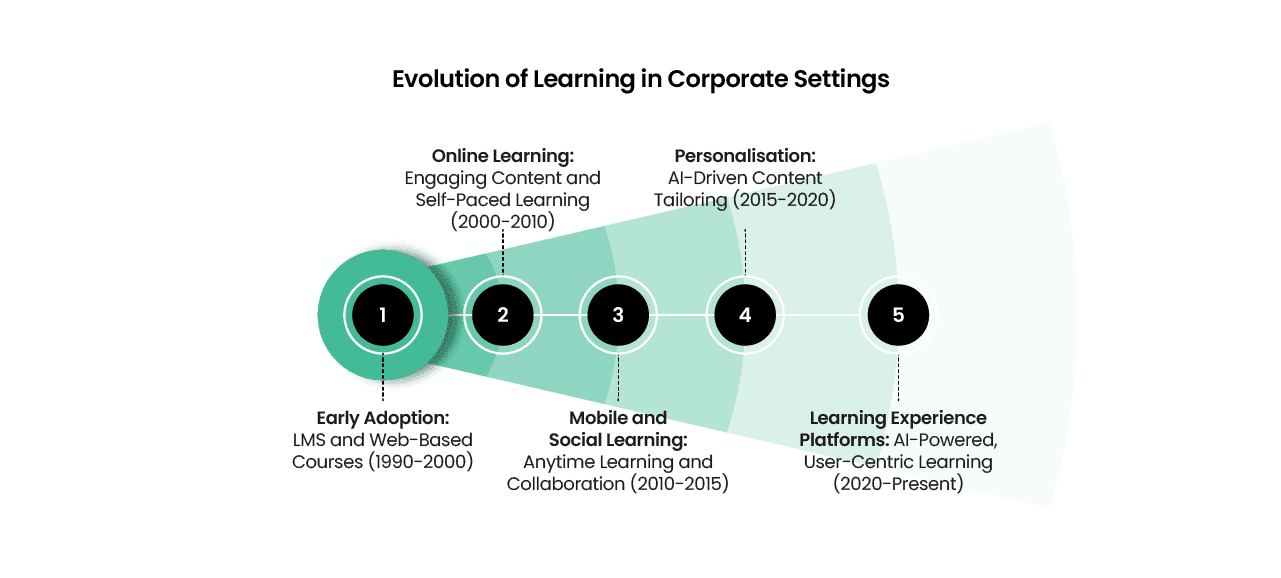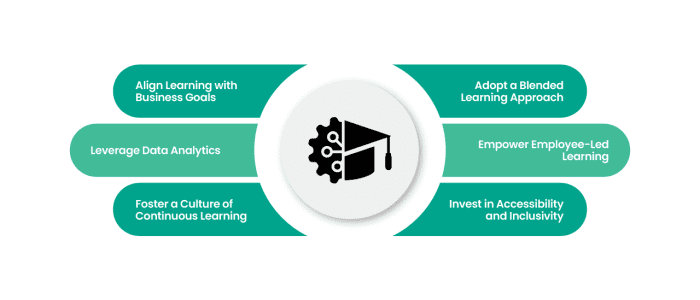Digital learning is crucial in upskilling and creating a lifelong culture of improvement and creativity. As organisations encounter rapid technological changes and shifting market dynamics, it has become essential to leverage digital platforms for employee training and development. To excel in their roles, individuals must acquire the most up-to-date knowledge and skills required in their fields.
A recent study by the Association for Talent Development revealed that organisations that utilise a mix of e-learning and traditional training methods experience an outstanding 42% increase in employee performance. Moreover, IBM estimates that the company gains a productivity increase of $30 for every dollar spent on eLearning products.
Additionally, businesses prioritising digital learning often see significant improvements in their performance metrics. By improving employee skills, organisations can achieve greater productivity, streamline processes, and enhance overall performance. In a rapidly changing environment, the ability to upskill and reskill employees through digital platforms is essential for companies to remain competitive and responsive to market shifts. As we continue to witness the evolution of work dynamics, understanding how to effectively harness digital learning will be crucial for individual and collective success within organisations.
This article examines the significant impact of digital technology. Employee development and its impact on business performance are crucial. As organisations increasingly embrace digital learning tools, employees can access a wealth of resources that enhance their skills and knowledge. This transformation enables staff to perform their roles more effectively, fostering a culture of adaptability, growth and Innovation.
EVOLUTION OF LEARNING IN CORPORATE SETTINGS
The corporate digital learning landscape has undergone significant transformations to adapt to emerging technologies, changing workplace demands, and evolving learner needs. In recent years, the rise of online platforms, mobile learning, and interactive tools has redefined how organisations approach employee training and development.
Initially, corporate training primarily relied on traditional in-person workshops and seminars. However, as digital technologies became more accessible and prevalent, companies began to recognise the benefits of online learning. This shift enables greater flexibility, allowing employees to learn at their own pace and according to their schedules.
Furthermore, integrating multimedia elements, such as videos, quizzes, and gamified experiences, has made learning more engaging and effective. Organisations are also leveraging data analytics to better understand employee learning preferences and track progress, allowing for a more personalised approach to development.
In this evolving landscape, companies must proactively provide digital learning opportunities that meet regulatory and compliance requirements and inspire continuous growth and innovation. By embracing these advancements, organisations can foster a skilled workforce well-equipped to drive business success in an ever-changing environment.
Having seen the impact of digital learning on employee performance, it’s important to understand how corporate learning has evolved to support these outcomes through several distinct stages, each reflecting the landscape of technology and employee needs:
-
Early Adoption: LMS and Web-Based Courses (1990-2000)
Organisations began implementing Learning Management Systems (LMS) to deliver structured online courses during this phase. This marked the initial shift from traditional classroom training to digital offerings, paving the way for broader access to educational content.
-
Online Learning: Engaging Content and Self-Paced Learning (2000-2010)
As digital capabilities advanced, the focus shifted towards creating more engaging and interactive online content. Self-paced learning became more popular, allowing employees to take responsibility for their learning journeys and progress through courses at their convenience.
-
Mobile and Social Learning: Anytime Learning and Collaboration (2010-2015)
The proliferation of mobile devices transformed corporate learning by providing employees with the ability to learn on the go. Social learning platforms emerged, fostering collaboration and knowledge sharing among peers and further enhancing the learning experience.
-
Personalisation: AI-Driven Content Tailoring (2015-2020)
As artificial intelligence technology matured, organisations began utilising AI to tailor learning content to individual employee needs. This personalisation ensured that training materials were relevant and engaging, significantly improving learning outcomes.
-
Learning Experience Platforms: AI-Powered, User-Centric Learning (2020-Present)
The latest stage involves the adoption of Learning Experience Platforms (LXP), which prioritise user experience and incorporate advanced AI features. These platforms offer a comprehensive, personalised learning environment that fosters continuous engagement and development, accommodating diverse learning styles and preferences.
As the corporate digital learning landscape evolves, organisations must stay agile and responsive to leverage these advancements, ultimately enhancing employee development and driving business performance.
Ways In Which Digital Learning Influences Employees’ Productivity
Digital learning has transcended its role as a support tool, becoming a critical driver of organisational performance. As companies in Nigeria and around the world face challenges such as cost pressures, talent shortages, and rapidly evolving skill demands, the transition to digital training is proving to be a game-changer.
Here are several ways in which digital learning enhances employee productivity:
1. Self-Paced Learning: Digital learning allows employees to engage with self-paced modules, significantly reducing downtime. By fitting training into their schedules, employees can learn without disrupting their workflow, thus maintaining productivity while acquiring new skills.
2. Targeted Reskilling: Focusing on specific skills that need enhancement, digital learning enables organisations to implement targeted reskilling programs that directly address gaps in knowledge. This acceleration in skill acquisition enables employees to contribute more effectively and efficiently to projects, thereby reducing overall execution times.
3. Access to Resources: Employees can access a wealth of online resources and training tools anytime, empowering them to find the information they need precisely when needed. This immediacy leads to quicker problem-solving and decision-making, improving output quality.
4. Scalability of Training: Digital learning programmes can be scaled easily to accommodate many employees simultaneously. This ensures that the entire workforce can benefit from training initiatives without the logistical constraints associated with traditional in-person training.
5. Enhanced Engagement: Integrating multimedia elements, gamification, and interactive content in digital learning platforms increases employee engagement. Higher engagement correlates with better knowledge retention and the practical application of skills, thereby boosting productivity.
6. Continuous Learning Culture: By fostering a culture of continuous learning, organisations encourage employees to seek opportunities for growth and improvement constantly. This proactive approach not only enhances individual performance but also contributes to the overall agility of the workforce, allowing the organisation to adapt swiftly to changing market demands.
Practical Strategies for Implementing Digital Learning Effectively
The following practical strategies outline how to make digital learning effective and results-driven:
1. Align Learning with Business Goals: Ensure every digital learning initiative is connected to measurable business outcomes such as sales growth, client satisfaction, or innovation.
2. Adopt a Blended Learning Approach: Combine digital modules with live coaching, peer discussions, and project-based learning to strengthen engagement and practical application.
3. Leverage Data Analytics: Use insights from learning platforms to monitor participation, assess skill development, and measure performance improvements in real time.
4. Empower Employee-Led Learning: Encourage employees to choose relevant learning paths, share resources, and contribute to internal learning communities that promote collaboration.
5. Foster a Culture of Continuous Learning: Celebrate learning milestones, integrate development goals into performance reviews, and ensure leadership visibly supports learning initiatives.
6. Invest in Accessibility and Inclusivity: Provide every employee with access to well-designed, mobile-friendly learning tools that support diverse learning needs and locations.
Conclusion
The shift to digital learning transforms how employees acquire skills and knowledge, driving productivity and enabling organisations to navigate challenges more effectively. By embracing digital training solutions, companies can enhance their workforce’s capabilities and responsiveness in an increasingly competitive environment.
Organisations that embrace eLearning are not just investing in training; they’re unlocking performance, agility, and innovation. As the digital economy accelerates, employees equipped with relevant digital skills will drive growth, resilience, and transformation.
At pcl., we deliver cutting-edge digital learning solutions across behavioural, technical, and industry-specific domains. Whether you’re preparing for the future of work or scaling your team’s performance today, our consultants are ready to help. Contact us at digitallearning@phillipsconsulting.net to learn more.
Written by:
Chidinma Orji
Digital Learning


